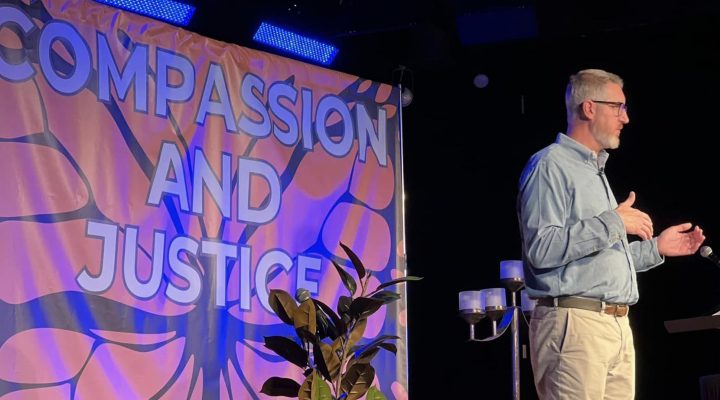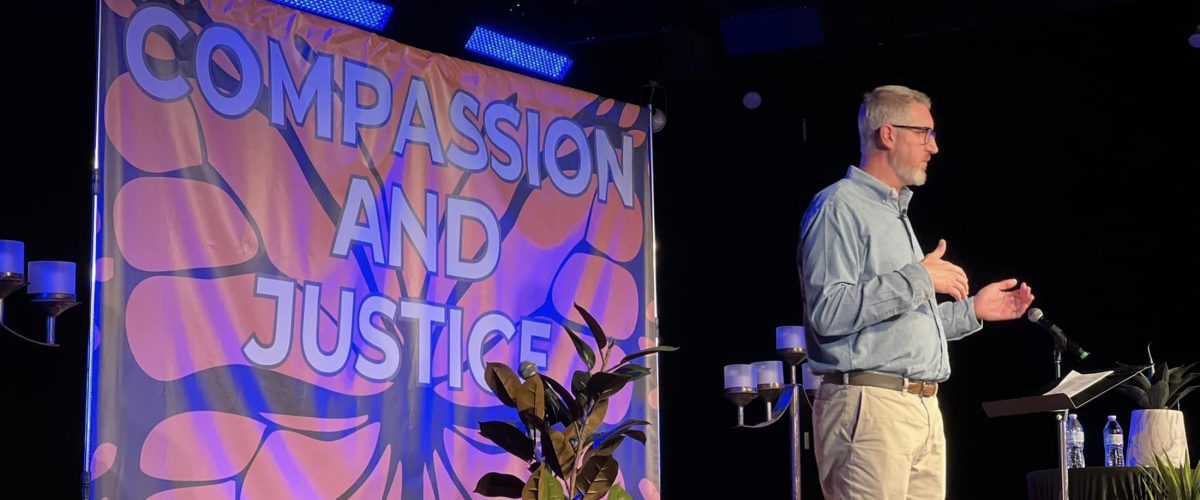Combating hunger isn’t optional for Christians who take the Bible and Jesus seriously, Jeremy Everett told participants in Fellowship Southwest’s Compassion and Justice Conference.
Scripture makes clear the imperative to share Christ’s heart for those struggling with food insecurity and others living on the margins of society, said Everett, executive director of Baylor University’s Collaborative on Hunger and Poverty.

Jeremy Everett
“Hunger was literally a litmus test for salvation in Matthew 25 where Jesus says, ‘I was hungry and you gave me nothing to eat.’ Jesus embodied a preferential option for the poor,” he said. “He taught it was those who are hated, excluded and reviled who are the ones that are blessed. Jesus identifies the poor as members of his family, and the rest of us are judged based upon whether or not we come to their aid.”
The Sept. 20-21 conference brought together activists from across Fellowship Southwest’s nontraditional Christian advocacy network focused on serving the most vulnerable in society. This year’s theme focused on “connection,” in reference to the organization’s “Compassion, Justice, Connection” tagline.
Everett is one of the nation’s leading food scarcity experts and author of I Was Hungry: Cultivating Common Ground to End an American Crisis. Through Baylor’s collaborative, he has spearheaded creative feeding programs including Meals-to-You, which helped feed thousands of children in Texas before expanding to other states and eventually being adopted for nationwide application by the federal government in 2023.
The U.S. has more people dying of starvation today than before 2020.
Huge strides in combating food insecurity were being made worldwide and in the U.S. before the COVID-19 pandemic, he said. With hunger levels cut in half during the preceding 40 years, the United Nations was emboldened to declare an end to global hunger by 2030. But now, 735 million people are facing hunger worldwide, including 82% of U.S. households with children. The U.S. has more people dying of starvation today than before 2020.
“What the hell happened?” Everett asked. For one, the war in Ukraine disrupted global grain exports, which contributed to a decline in fertilizer production. “Southeast Asia and much of the eastern coast of Africa are dependent both on that grain and on that fertilizer, so production levels in many of these countries went down 70%, leading to skyrocketing rates of malnutrition.”
The pandemic and international conflict also worsened food insecurity by exacerbating social injustices, including racism and poverty, he added. “Since virtually all injustices result in growing rates of hunger, it is a yardstick, a litmus test for our world, our nation and our communities. Look at the justifications being given for children dying of starvation in Gaza in a conflict that children did not perpetrate.”
In the U.S., the leading predictor of food insecurity is disability, especially in aging households on fixed incomes where isolation limits access to food, Everett said. “The second one is structural racism. Here we are in 2024, toward the end of 2024, and if you live in a Black or brown household, you’re still three times as likely to be food insecure as your white counterparts.”
People enmeshed in the nation’s criminal justice system are next in line as likely to experience hunger, he added. “But it’s not just them, but their family members. And if you live in a neighborhood that has a high rate of people caught in the carceral system, you’re three times as likely to be food insecure.”
Underemployment is another significant predictor of hunger in the U.S., as people working minimum-wage jobs rarely earn more than $15,000 annually and are challenged to pay for health care, child care and transportation, let alone food, he continued. “So underemployment and incarceration, disability, structural racism, all these things leave families at that level that forces them to make tradeoffs. They have to decide each month what they are going to pay for.”
While government can provide feeding programs to combat hunger, especially in children, churches can help by declaring themselves hunger-free congregations or by joining coalitions determined to eradicate local food insecurity, he advised. “We have a great coalition that’s been active here in the Dallas community for the past 12 years. The 400 participating organizations are working in concert with each other to ensure that nobody goes hungry.”
Churches also can come alongside schools to help serve students eligible for subsidized breakfast and lunch programs, or to ensure schools are using such programs for students in need, he said. “You don’t have to add more money to your food budget at your church. You just have to be a good resource and a good neighbor to your schools and your communities to make sure children have access to that breakfast.”
Christians also can appeal directly to government officials and agencies on behalf of those experiencing food insecurity in their communities, Everett concluded. “Whether we like it or not, whether we have been aware of it or not, whether the issue directly affects you and your family or not, hunger is a litmus test for you. It’s a litmus test for me. Together, we must join hands with our brothers and sisters desperate for salvation in the here and now.”
Related articles:
Look past fear and scarcity to embrace migrants, Carvalhaes urges
‘If we weren’t powerful, they wouldn’t try to stop us,” Justin Jones says


